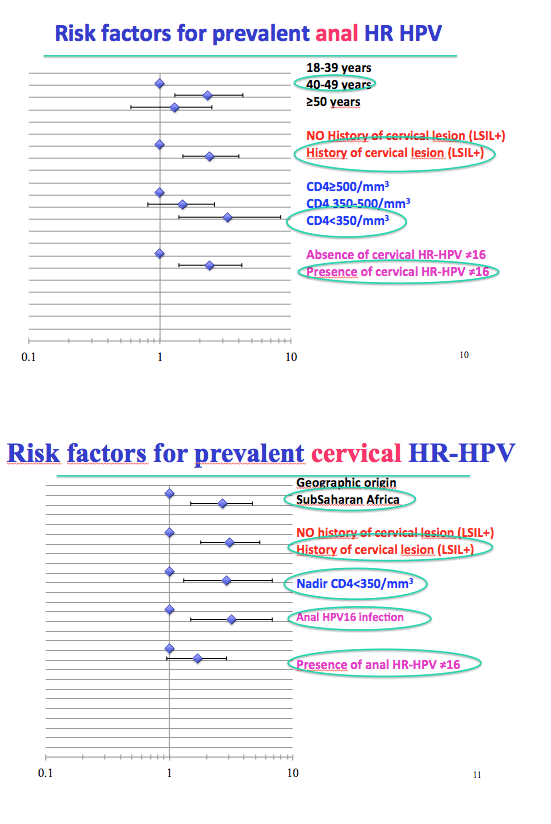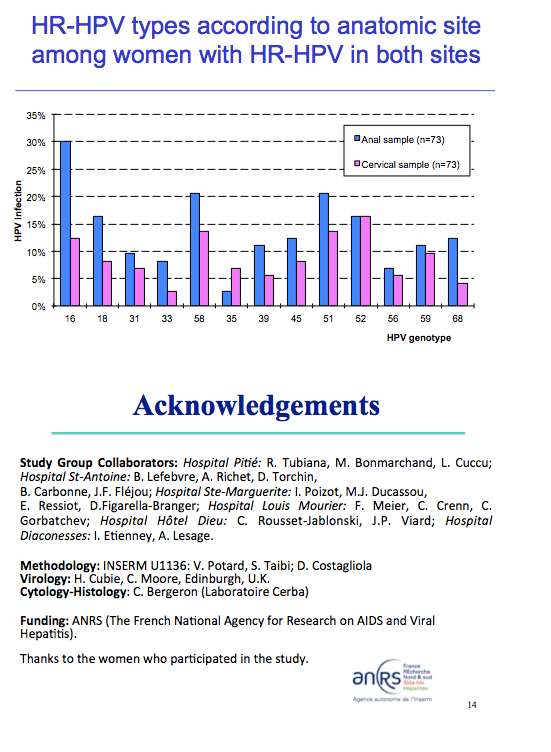 |
 |
 |
| |
High-Risk HPV 60% More Frequent in Anus
Than Cervix of HIV+ Women in France
|
| |
| |
ICAAC 2014. September 5-9, 2014. Washington, DC
Mark Mascolini
High-risk (cancer-causing) human papillomavirus (HPV) types proved 60% more frequent in anal than cervical samples in 311 HIV-positive women in France [1]. HPV-16, the leading cause of anal cancer, was more prevalent in anal than cervical samples.
HPV infection can lead to cervical cancer, anal cancer, and other cancers in people with and without HIV, but HIV increases the cancer risk. HPV research in HIV-positive women has focused on the cervix, and cervical cancer is an AIDS cancer. But recent studies show that 20% to 50% of HIV-positive women have receptive anal sex--which puts them at risk of anal HPV infection--and women with HIV run a higher risk of anal intraepithelial neoplasia than women without HIV [2].
More than a dozen HPV genotypes are ranked as high-risk types because of their association with cancer development. Two high-risk types (HPV-16 and HPV-18, both covered by the bivalent and quadrivalent vaccines) cause about 80% of anal cancers. The French team noted that there is no consensus on optimal screening for anal cancer in women with HIV.
The French study enrolled 311 women from clinical sites across France in 2012. All women had anal and cervical samples collected fewer than 6 months apart. The researchers genotyped all samples and characterized them as high-risk or low-risk. Women also underwent high-resolution anoscopy.
Median age of study participants stood at 45 years, and 43% of women came from sub-Saharan Africa. Because of their age, these women had not had HPV vaccination. They had HIV infection for a median of 15.5 years, and 96% were taking combination antiretroviral therapy. Median CD4 count stood at 612, and 84% of women had a viral load below 50 copies. Half of the women had a history of low-grade squamous intraepithelial lesions (LSIL), and 25% had been treated for LSIL.
The researchers detected high-risk HPV types in the cervix of 104 women (33.4%), while identifying high-risk types in the anal canal of 170 women (54.7%), a highly significant difference (P < 0.0001). Those rates mean high-risk HPV was 60% more prevalent in anal samples from these women.
HPV-16, the leading culprit in anal cancer, proved the most prevalent HPV type in anal samples (13.2%), while appearing in about 5% of cervical samples (P = 0.0002). HPV-16 was the second most prevalent type in cervical samples. Anal samples had a higher rate of infection with multiple HPV types than did cervical samples (80.5% versus 66.3%, P < 0.0001). All high-risk HPV types except HPV-35 and HPV-66 were more frequent in the anal canal than in the cervix. High-risk HPV types correlated poorly in cervical and anal samples of individual women.
While 23.5% of women had both anal and cervical high-risk HPV, 31.2% had only anal high-risk HPV, 9.9% had only cervical high-risk HPV, and 35.4% had neither.
Multivariate analysis determined that a current CD4 count below 350 more than tripled chances of high-risk HPV detection in the anal canal (odds ratio 3.2, 95% confidence interval 1.3 to 7.9). A history of cervical lesions more than doubled the odds of high-risk HPV in the anal canal (odds ratio 2.4, 95% confidence interval 1.5 to 4.0). Age 40 to 49 (versus 18 to 39) and having cervical high-risk HPV were also independently associated with anal high-risk HPV. Anal sex was not a risk factor for high-risk anal HPV.
Factors independently associated with cervical high-risk HPV were sub-Saharan origin, a history of cervical lesions, a nadir CD4 count below 350, and anal HPV-16 infection. Presence of other anal high-risk HPV types was marginally associated with prevalent cervical high-risk HPV.
The French team hypothesized that longer persistence of nontransforming HPV infection in the cervix (which is not treated) allows high-risk HPV transmission to the anal canal. They believe the high prevalence of high-risk HPV in anal samples from these HIV-positive women "gives cause for concern." Without screening, anal HPV goes undetected, "opening the door for future anal disease and cancer in HIV-positive women." The researchers proposed that anal cancer screening should be offered to HIV-positive women during gynecologic exams.
References
1. Heard I, Poizot-Martin I, Potard V, et al. High prevalence of oncogenic HPV infection in anal canal versus cervix in HIV-infected women in France. ICAAC 2014. September 5-9, 2014. Washington, DC. Abstract H-1199.
2. Mascolini M. Soaring anal cancer incidence in the combination ART era. RITA. 2013;18:5-24. http://centerforaids.org/pdfs/rita1213.pdf






|
| |
|
 |
 |
|
|